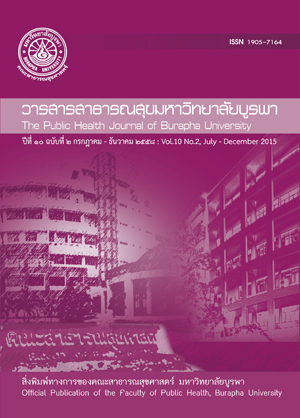การประเมินต้นทุน-ประสิทธิผล โครงการเคลือบหลุมร่องฟันให้กับนักเรียนชั้นประถมศึกษา
Main Article Content
บทคัดย่อ
งานวิจัยนี้มีวัตถุประสงค์เพื่อประเมินความคุ้มค่าของโครงการเคลือบหลุมร่องฟันด้วยวิธีการวิเคราะห์ต้นทุน-ประสิทธิผลและศึกษาความสัมพันธ์ระหว่างศาสนากับการเกิดโรคฟันผุในเด็กเพื่อพิจารณาว่าปัจจัยดังกล่าวส่งผลกระทบต่อนโยบายในการจัดทำโครงการฯอย่างไรกลุ่มตัวอย่างในการวิจัยนี้คือนักเรียนจากพื้นที่รับผิดชอบของโรงพยาบาลลำลูกกาแบ่งออกเป็น2กลุ่มโดยตามการพิจารณาความลึกของหลุมร่องฟันโดยทันตแพทย์ได้แก่กลุ่มเข้าร่วมโครงการฯจำนวน312คนและกลุ่มที่ไม่ได้เข้าร่วมโครงการจำนวน174คนจาก22โรงเรียนผลการวิเคราะห์พบว่าค่าดัชนีโรคฟันผุของทั้ง2กลุ่มมีค่าใกล้เคียงกันและกราฟค่าต้นทุน-ประสิทธิผลส่วนเพิ่ม(IncrementalCostEffectivenessRatio)ได้แสดงให้เห็นว่าหากประเมินจากค่าใช้จ่ายของโครงการเป็นหลักโครงการนี้ไม่มีความคุ้มค่าในการลงทุนสาเหตุเกิดจากวิธีการคัดเลือกเด็กเข้าร่วมโครงการฯยังไม่สะท้อนถึงกลุ่มที่มีความเสี่ยงต่อการเกิดโรคฟันผุอย่างแท้จริงควรนำปัจจัยด้านศาสนาเข้ามาใช้เพื่อการพิจารณาด้วยอีกทางหนึ่งอย่างไรก็ตามหากนำเอาประโยชน์ที่นักเรียนและผู้ปกครองได้จากการประหยัดเวลาและค่าใช้จ่ายในการดูแลรักษาฟันในระยะยาวเข้ามาคำนวณด้วยก็อาจได้ผลความคุ้มค่าที่เพิ่มขึ้นนอกจากนั้นยังควรทำการศึกษาปัจจัยที่มีผลต่อการเกิดโรคฟันผุเพิ่มเติมเพื่อเพิ่มประสิทธิภาพให้กับโครงการทั้งทางด้านการพิจารณาเด็กเข้าร่วมโครงการฯและการประยุกต์จัดทำกิจกรรมซึ่งเป็นประเด็นที่ควรทำวิจัยต่อไป
The Cost-Effectiveness of the Prevention of Dental Caries among Primary School Students
This paper assesses incremental cost effectiveness ratio (ICER) of a dental sealant project conducted at 22 primary schools near Lam Lookga hospital, Pathum Thani Province. Total of 486 primary school students at year 3 are examined in this exercise. Of these 486 students, 312 students participated in the project and 174 students did not participate in the project. It has been found that the average values of Decayed/Missing/Filled/Teeth (DMFT) of participants and non-participates are almost identical. Consequentially, the ICER analysis indicated that the project fails the test for cost effectiveness. Such failure can be attributed to several factors. These include delayed and infrequent provision of sealants. This project was not worthwhile investment due for sampling in research does not reflect the risk of dental caries. However, if non-monetary and long-term benefits in term of cost saving were to be included in the analysis, the results might be different. Moreover, the religion of population and the cause of dental caries should be included in the analysis to increase the efficiency of the project.
Article Details
เอกสารอ้างอิง
& Douglass. Risk assessment criteria applied to a screening exam: implication for improving the efficiency of the sealant program. Journal of Public Health Dentistry. 2005; 65 (4) : 203-208.
2. Supanantaporn Jariya. The impact of oral status on daily performances among 6th grade primary school children in Bangbon District, Bangkok. [Master of Primary Health Care Management]. Bangkok: Mahidol University; 2009.
3. กรมอนามัย. คู่มือดำเนินงานโครงการหลักประกันสุขภาพถ้วนหน้า ปี 2548 โครงการส่งเสริมสุขภาพและป้องกันโรคด้านทันตกรรมสำหรับเด็ก ยิ้มสดใสเด็กไทยฟันดี.กรุงเทพมหานคร : ออนพริ้นช้อพ; 2548.
4. เพ็ญแข ลาภยิ่ง และคณะ. หนึ่งปียิ้มสดใสเด็ก กทม.ฟันดี : การประเมินโครงการ. พิมพ์ครั้งที่ 1. สุพรรณบุรี : ออฟเซทอาร์ตออโตโมชั่น; 2549.
5. งานประชาสัมพันธ์ มหาวิทยาลัยรามคำแหง. ผลสำรวจพฤติกรรมการบริโภคขนมขบเคี้ยวของ
เยาวชน [ออนไลน์]. [เข้าถึงเมื่อวันที่ 21 พฤศจิกายน 2555] เข้าถึงได้จาก http:// www.info.ru.ac.th.
6. Petersen PE. Sociobehavioural risk factors in dental caries – international perspectives.
Community Dent Oral Epidemiol. 2005; 33 : 274-9.
7. Baelum V, Pongpaisal S, Pithpornchaiyakul W, Pisuithanakan S, Rawee T, Panos NP, Gunnar D. & Ole F. Determinants of dental status and caries among adults in southern Thailand. [online]. [Retrived 1 March 2014] from http://www.hawaii.edu/hivandaids/Determinants_of_Dental_Status_and_Caries_Among_Adults_in_Southern_Thailand.pdf.
8. Ceri P. & Guy Thompson P. What is...? series health economics [online]. [Retrived 1 November 2012] from http://www.whatisseries.co.uk.
9. Sassi Franco. How to do (or not to do) . . . calculating QALYs, comparing QALY and DALY calculations [online]. [Retrived 1 November 2012] from http://heapol.oxfordjournals.org.
10. Mehrotra V, Gupta R, Sawhny A, Agarwal S., Gupta I. & Garg K. Cultural, Religious, social and personal customs “a boon or bane” for oral and general health. [online].[Retrived 1 March 2014] from http://www.johcd.org/pdf.
11. Wei Ouyang. Cost-effectiveness analysis of dental sealant using econometric modeling. [Doctor of Philosophy]. America: University of Minnesota; 2009.
12. Arrow P. Cost-minimization analysis of two occlusal caries preventive programmes [online]. [Retrived 1 March 2014] from http://www.ncbi.nlm.nih.gov/pubmed/11349992.

